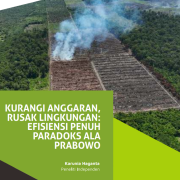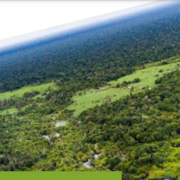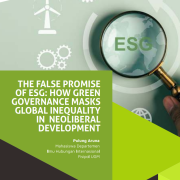Revisiting the Dominant Narrative of Green Energy: How do Structural Problems Lead to Fostering Resilience?
The discourse surrounding green energy emerges as a response to the climate crisis, a transnational issue causing growing frustration among societies due to its disruptive effects. The predominant set of parameters for green energy implementation pertains to the utilisation of energy derived from natural resources like sunlight, wind, or water, which have minimal or no impact on the world’s carbon footprint (Kalyani et al., 2005; Berdikeeva, 2024; TWI, n.d.). While the overarching goal of this discourse is clear, its implementation is complex. Research by the United Nations Conference on Trade and Development (2023) indicates that achieving this energy transition would require approximately $5.8 trillion annually from 2023 to 2030 for the 48 developing economies studied, equivalent to 19% of their GDP. Beyond financial capacity, the ability to navigate the technical intricacies of transitioning from conventional to green energy is equally vital for the success of this agenda.
Furthermore, the World Bank (2023) acknowledges the asymmetrical relationship between the North and South within this discourse, resulting in a significant gap hindering its realisation in the South. In the South, several issues are prevalent, including higher electricity costs, limited access to clean energy projects, and dependency on fossil fuels (World Bank, 2023). Hence, alternative perspectives on the green energy discourse are essential, offering new approaches to strategically implementing it in this hemisphere.
A thorough appreciation of green energy’s benefits is essential in addressing the ongoing climate crisis and its tangible impacts. Building on Kraemer’s (2017) insights, green energy serves societal and environmental aspects and reshapes the energy landscape by diminishing the relevance of conventional sources and eroding fossil asset values. This shift affects various sectors, including capital formation, international trade, economic activity, and government revenue. While adopting green energy is becoming increasingly normalised, structural challenges persist, particularly in the South. Despite the widespread dissemination of the green energy discourse in this region, structural barriers hinder its effective implementation. Given that the fundamental issue of asymmetrical power remains inadequately addressed, it is imperative to revisit the political dynamics inherent in this discourse.
As the objective of this discourse is to positively heal the world’s wounds due to the massive unsustainability practices, the reality of this discourse seems like a tale for the South, considering the structural problem mentioned above. As the asymmetrical power structure is the heart of postcolonial governance, the discourse of green energy is nothing more than a sugarcoating for the domination agenda. In other words, the discourse of green energy is used to perpetuate the domination of the North toward the South.
The dominant green energy agenda presents a ‘false promise.’ The narrative surrounding green energy is widely disseminated to the South to mitigate emissions. This approach seems logical given that the economic growth of the South is fueled by deforestation, which accounts for 63 per cent of annual emissions (Center for Global Development, n.d.). However, this article contends that this initiative enables the North to ‘take the lead’ in promoting green energy, albeit with self-interest masked as an environmental concern. In essence, it embodies a form of green colonialism.
For example, in 2021, natural gas reached record highs in Europe due to scarcity, allowing Norway, one of the largest suppliers, to capitalise on the situation. In response to the shortage, Norway agreed to increase its natural gas exports by two million cubic meters. While benefiting from the rise in gas prices, Norway exploited this situation by attempting to hinder natural gas exports from the South. Additionally, the country lobbied the World Bank to cease all financing for natural gas projects in Africa and other regions by 2025, advocating instead for investments in clean energy solutions such as green hydrogen and intelligent micro-grid networks in southern countries (Ramachandran, 2021). Indeed, while this policy may appear commendable, its feasibility is questionable. The exorbitant costs and the limited capacity of Southern nations to develop such energy sources render its implementation unlikely. This implies that policies formulated by the North are often self-serving and do not effectively address the underlying issues, thereby impeding the growth potential of the South. It echoes Said’s (1978) idea toward the postcolonialism approach, which believes that existence structure and inherent knowledge originate from the North, with the South merely conforming to preset norms. Consequently, adopting Northern-driven knowledge fails to address the actual needs of the South.
Furthermore, this issue highlights a paradox – while urging the South to adopt green energy initiatives, the North often pays no heed to its environmentally disruptive practices. Hence, we must consider the question Chang (2002) raised – are the ‘good policies’ endorsed by the North suitable for implementation in the South?
Taking a more comprehensive view of the North’s strategy to promote the green energy transition agenda mainly revolves around providing aid. Bringing Indonesia into focus, the World Bank has indeed supported implementing sustainable electricity projects in Indonesia, particularly in the eastern region. According to a report from 2023, the World Bank has allocated US$500 million in financial support for this project. While financial support undoubtedly plays a crucial role in advancing the agenda, questions regarding sustainability and effectiveness remain paramount. Echoing the sentiments of Hattori (2001), the provision of aid represents a power dynamic between the recipient and the donor, embodying the notions of domination and subordination under the guise of generosity and gratitude. Essentially, it underscores material inequality, where one party possesses resources while the other lacks.
Moreover, Hattori (2001) posits that this reflects a subtle hierarchical relationship, indicating a dynamic of superiority and inferiority. Thus, it transcends mere development agendas for the South; rather, it pertains to wielding soft power in the Southern Hemisphere. Beyond simply highlighting the asymmetrical power demonstrated by this scheme, it is essential to question how financial support, often provided in the form of loans, can create a sustainable mechanism for realising green energy projects.
Moreover, what parameters are in place to gauge the success of project implementation solely based on financial support without considering technology capacity? Emphasizing the disparity is a crucial aspect. McDonald & Vaughan (2023) have highlighted that higher capital costs and risks in many South countries contribute to gaps in infrastructure, systems, and policies necessary for new technologies to compete with incumbent systems like coal. Additionally, there are challenges regarding the standardisation of green energy implementation. For instance, in the case of solar energy, McDonald & Vaughan (2023) found that there are still no standards for solar panels to withstand exposure to sand, which is essential for countries such as Morocco, Mongolia, and Egypt. Therefore, providing financial support without accompanying technology transfer initiatives is unlikely to be effective.
Political corruption is another issue contributing to the hindrance of green energy implementation, which disrupts the momentum of transitioning to green energy. Therefore, while the discourse of green energy remains beneficial in dismantling the dominance of conventional energy usage, structural issues persist and must be addressed.
Indeed, structural problems are a vital issue that must be addressed to implement green energy discourse successfully. However, this article argues that addressing this problem is not the sole solution. Instead, these structural problems provide an opportunity for the South to deconstruct the concept of green energy as conceived by the North. This deconstruction is crucial for effectively addressing climate damage and loss and demonstrating that the South can critically engage and generate its contextualised knowledge, aligning more closely with the region’s needs.
The dominant narrative of green energy aims to shift from conventional, fossil-based energy to clean sources. However, if this notion is strictly applied to the South, progress may be slow. It is essential to recognise the South’s dependence on conventional energy sources. In a specific context, Indonesia continues to face challenges in reducing carbon emissions, given its significant reliance on coal and natural gas exports, which account for nearly 20% of its emissions. In 2021, the country’s energy sector alone emitted approximately 600 million tonnes of carbon dioxide (Mt CO2), ranking Indonesia as the world’s ninth-largest emitter (International Energy Agency, 2022).
Considering all these factors, it becomes apparent that the discourse surrounding green energy will have a less significant impact due to the dependency on conventional energy. This implies that the dominant narrative of green energy, which emphasises replacing conventional energy with clean alternatives, will be ineffective due to its exclusive parameters in defining green energy. Shifting the focus of green energy towards localised approaches rather than generalised concepts could significantly mitigate the disruptive impacts caused by conventional energy use.
This article argues that green energy entails more than just an absolute replacement of conventional energy; it involves gradually altering behaviours towards sustainability while reducing reliance on conventional energy sources. As international governance has a slow pace of implementing the idea of green energy, it is giving room for the local communities to build a niche toward green energy, giving the alternative idea that is more contextual and implementable. Research conducted by Yuana et al. (2024) reveals that educational institutions significantly impact changing community behaviour towards sustainability through the concept of the Circular Economy.
In simple terms, Circular Economy advocates for practices aimed at reducing raw material consumption by reconsidering product design for recyclability, prolonging product life spans through maintenance and repair, utilising easily recyclable materials, and reintroducing raw materials into the disposal stream (Van Buren et al., 2016 in Yuana et al., 2024). Several schools in Java have already implemented programs promoting Circular Economy practices. For example, at SD Muhammadiyah Ketanggungan, the school principal has incorporated the Circular Economy agenda into the curriculum, emphasising classroom recycling practices. This initiative stems from the awareness of the environmental challenges faced.
Recognising that our cafeteria generates a significant amount of organic waste, we have identified an opportunity to repurpose it as food for maggots, serving as fish feed. – Naneh Dhahneh, M.Pd (Yuana et al., 2024).
Although the initiatives undertaken by SD Muhammadiyah Ketanggunan may not be explicitly linked to the production of green energy, these practices should be appreciated as a starting point for making a more significant contribution to the concept of green energy. The key takeaway from these examples is the resilience of non-state actors in the face of slow progress in mitigating climate change. The idea of converting waste into energy could also be implemented by changing the community’s behaviour towards more sustainable practices. It takes time, but at least the idea exists and is in the nurturing process.
Another example comes from Kalangbangi Kulon Village, Gunung Kidul. The community there recycles animal-based waste into biogas, providing an alternative energy source for cooking. Although this biogas utilisation may only suffice for part of the day due to material scarcity (Wardhana, 2013), it still demonstrates the community’s resilience in the face of the disruptive impacts of widespread conventional energy use.
At the very least, this article illustrates that transformation does not always have to originate from dominant narratives or top-down approaches; local knowledge can significantly contribute to environmental sustainability. Even if it begins on a small scale, collaborative efforts among stakeholders to mainstream these initiatives can pave the way to unlock a new regime. Therefore, there is room to resist dominant Northern knowledge by reappropriating it into local contexts.
References
Berdikeeva, S. (2024, March 6). Green Energy. Save on Energy. Accessed on 28 March, 2024, from https://www.saveonenergy.com/green-energy/.
Center for Global Development. (n.d.). Climate Change and Development in Three Charts. Accessed on 28 March, 2024, from https://www.cgdev.org/blog/climate-change-and-development-three-charts.
Chang, H. (2002). Introduction: How did the Rich Countries Really Become the Rich? Kicking Away the Ladder. Anthem Press.
Hattori, T. (2001). Reconceptualising Foreign Aid. Review of International Political Economy, 8(4), 633–660. http://www.jstor.org/stable/4177404.
International Energy Agency. (2022). An Energy Sector Roadmap to Net Zero Emissions in Indonesia. https://www.iea.org/reports/an-energy-sector-roadmap-to-net-zero-emissions-in-indonesia.
Kalyani, L. V., Dudy, K. M., & Pareek, S. (2015). Green energy: The need of the world. Journal of Management Engineering and Information Technology (JMEIT), 2(5). ISSN: 2394 – 8124.
Kraemer, R. A. (2017). Green Shift to Sustainability: Co-benefits and Impacts of Energy Transformation. Centre for International Governance Innovation. http://www.jstor.org/stable/resrep16149.
McDonald, B., &Vaughan, S. (2023, November 8). Rethinking Technology Transfer to Support the Climate Agenda. International Institute for Sustainable Development. Accessed on 28 March, 2024, from https://sdg.iisd.org/commentary/guest-articles/rethinking-technology-transfer-to-support-the-climate-agenda/.
TWI. (n.d.). What is Green Energy? (Definition, Types, and Examples). Accessed on 28 March, 2024, from https://www.twi-global.com/technical-knowledge/faqs/what-is-green-energy.
United Nations Conference on Trade and Development. (2023). The costs of achieving the SDGs: Energy transition. Accessed on 20 March, 2024, from https://unctad.org/sdg-costing/energy-transition.
Wardhana, W. (2013, December 19). Pakai Biogas Jadi Lebih Hemat. Solo Pos Jogja. Accessed on 24 March, 2024, from https://jogja.solopos.com/pakai-biogas-jadi-lebih-hemat-475728.
World Bank. (2023, June 26). World Bank Supports Increased Access to Sustainable and Lower-Cost Electricity in Eastern Indonesia. Accessed on 20 March, 2024, from https://www.worldbank.org/en/news/press-release/2023/06/26/world-bank-supports-increased-access-to-sustainable-and-lower-cost-electricity-in-eastern-indonesia.
World Bank. (2023, May 16). Breaking Down Barriers to Clean Energy Transition. Accessed on 20 March, 2024, from https://www.worldbank.org/en/news/feature/2023/05/16/breaking-down-barriers-to-clean-energy-transition.
Yuana, L. S., Wiliyanto, W., Hadiyantono, A. T., Figueora, J. M., Hapsari, M., & Br Pinem, L. M. (2024). Mundane circular economy policy: Mainstreaming CE education through the agency of schools. Journal of Cleaner Production, 440. https://doi.org/10.1016/j.jclepro.2024.140847.
.











Leave a Reply
Want to join the discussion?Feel free to contribute!